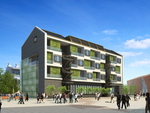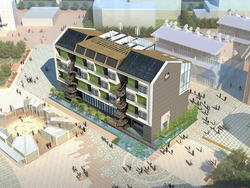The Ecohome, prototype house of the future, at the Shanghai universal exhibition
Some 200 nations and international organisations applied their best creativity to design a new type of building for the Shanghai Universal Exhibition to be held from May 1 to October 31 2010. The Ecohome house stands out among them. It is a genuine digest of innovations applied to Chinese buildings and life styles, it will be located in the best urban practices area and will represent the City of Shanghai.
It was built by the SRIBS (Shanghai Research Institute of Building Sciences), and is intended to be a prototype sustainable house of the future, to be replicated throughout China after the exhibition. It is located in the best urban practices area of the exhibition, and presents the highest performance ecological methods and systems in a fun and instructive manner. The external architecture of the building uses and demonstrates new passive and active energy saving technologies (in particular wind generators and large windows) while maintaining details of traditional Chinese and Shanghai architecture. There is a door in it from Shanghai's Xintiandi district and windows are designed to look like traditional Chinese windows.
Future typical house in China?
The Ecohome was designed to last and to act as a model for future real estate developments in China and even in other countries. It presents innovative technologies designed to reduce energy and resource consumptions, and technologies that will improve comfort in the future. The SRIBS called in the most innovative Chinese and foreign contractors to make this building into a reference for the future.
CSTB has been working with SRIBS for many years, and shared its scientific and technical expertise to evaluate the building's environmental performances. Cooperation applied to the evaluation of energy performance, quality of internal ventilation and the acoustic environment. The emphasis was also placed on the suitability of lighting to satisfy needs and the use of virtual reality in monitoring and control of building consumption.
Thus, CSTB organised several workshops with SRIBS and French contractors working on the project to present these pioneer aid methods to participants and give them an opportunity to start using them. French companies thus offered their most innovative products and systems in order to reduce energy consumption and improve the quality of indoor space. SRIBS chose five French companies to install their products in the Ecohome and maintain them throughout the exhibition.
More companies from France invested in this project than from any other country. Companies from other nations include Philips that is the largest sponsor with an investment of 1 M€. It supplied LED lighting, a 3D television that does not require special glasses, and a bed capable of measuring the blood pressure.
Nevertheless, Ecohome was not designed as a commercial site but rather as a place in which the visitor can experiment and make his own discoveries. Many surprises and much entertainment will punctuate the visit and many conferences will be organised during the six months of the exhibition. The Ecohome will be a place for learning and discovery until the end of the exhibition, and especially an example to be followed for construction in the future.
Input by French manufacturers?
- Integrated management
Schneider Electrics is in charge of the Intelligence Technologies in the building. It has designed and installed the computer control of the whole construction as a means of total integration of the information inside the building. This technology will allow the measuring of the consumption of every resource and for each use in the building. It will be possible to know how much energy the elevator or the TV uses and how much water is pulled at each tap, or per day or week. Schneider will be in charge of controlling this incredible system during the whole expo, which constitutes a challenge the firm can be proud of.
- Insulation
Saint-Gobain Weber has contributed to the insulation of the walls implementing a new mortar. This external façade insulation system is made of panels to be placed at the exterior of the walls and of two layers of decorative rendering to be placed directly on the panels. Using this method keeps the interior of the building warm in winter and cool in summer, helping to reduce the need for artificial heating and cooling. Moreover and unlike others insulation products, it prevents condensation from occurring and eliminates the risk for damp walls and fungus infestation, a recurrent problem in humid region as Shanghai’s. Saint-Gobain Glass has provided low-e glass, with reinforced heat insulation ability and higher light transmittance rate. At the same time, it has better performance in heat insulation, and shows its contribution in creating low carbon environment.
- Solar protection and blinds
Glen Raven participated in the setting of the shading system by installing blinds called Sunworker (a technical solar protection fabric manufactured by Dickson the French subsidiary of Glenraven). These blinds act as thermal filters through the reflection and absorption of solar energy. They enable the rooms to stay cooler in summer and warmer in winter by controlling the solar rays they receive and preventing the inside heat of the rooms from escaping in winter. Moreover, they prevent glow and diffuse light harmoniously.
Somfy provided the motors and controls that allow the building to benefit from the natural elements and energies through its envelope. The solar protections and windows are moved to the right positions to create, in an energy efficient way, a healthy, comfortable and practical interior environment.
- Internal comfort
Lafarge provided gypsum board systems for the partition walls and ceiling of the Ecohome, ideal to create a comfortable living environment. Traditional clay and cement brick partitions have been replaced by gypsum partition walls (123mm). Thinner than a cement brick wall (150mm-200mm), these gypsum partitions also offer much better acoustic and thermal performance. Gypsum board has low thermal conductivity. Furthermore, the gypsum boards used in the Ecohome are made from synthetic gypsum, a by-product of the desulphurization of gases at electric power plants and used instead of natural gypsum, therefore reducing the consumption of non-renewable resources.
Chinese eco-cities and sustainable buildings of the future
The CSTB project is mainly financed by a FASEP fund (fund for study and help to the private sector administered by the DGTPE from the French Economic Ministry).
It falls within the framework of the DUD agreement signed in 2007 between the MEEDDM and its Chinese equivalent, the MOHURD. It aims at creating synergies between innovative French firms, which have until now offered separate systems and products, in order to build sustainable buildings and cities. The CSTB (French Scientific and Technical Construction Center) brought its scientific and technical expertise to develop concepts and guidelines to build eco-cities and sustainable buildings, as a support of an integrated offer of systems and products. The project has been done in cooperation with the SRIBS, CSTB’s counterpart in Shanghai.
An urban design workshop took place in March 2009, with the participation of 80 international urban planners and engineers in partnership with Tongji University, l’Ecole des Mines de Paris and Cornell University, along with a dozen French firms. It led to innovative propositions for the development of one of the ecocities of the Chinese national program: Hulu Dao in the Liaoning.
CSTB's "Chinese Ecocities and Sustainable Buildings of the Future" project will be completed at the end of the year 2010 by a second town planning workshop (probably in the Shanghai region) and by the publication of a book on urban development at the scale of a district and entire town that will be complementary to the Sustainable Design Handbook China published in 2006 dealing with sustainable building. CSTB will be in China during the 2010 Universal Exhibition during the different conferences organized in the French pavilion, the City of Shanghai pavilion and the Rhône Alpes Region pavilion.


